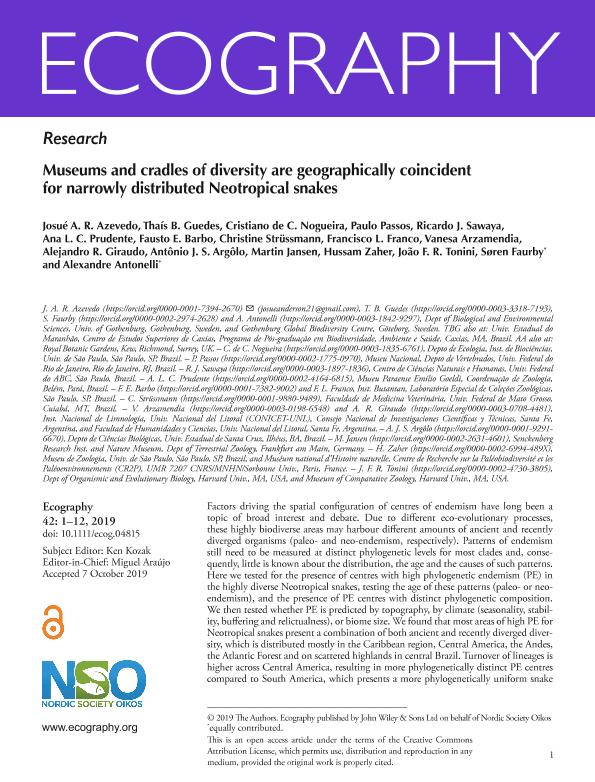Artículo
Museums and cradles of diversity are geographically coincident for narrowly distributed Neotropical snakes
Azevedo, Josué Anderson Rêgo; Guedes, Thaís B.; Nogueira, Cristiano de Campos; Passos, Paulo; Sawaya, Ricardo; Prudente, Ana; Barbo, Fausto Erritto; Strüssmann, Christine; Franco, Francisco L.; Arzamendia, Vanesa ; Giraudo, Alejandro Raul
; Giraudo, Alejandro Raul ; Argolo, Antonio; Jansen, Martin; Zaher, Hussam; Tonini, Joao Filipe Riva; Faurby, Søren; Antonelli, Alexandre
; Argolo, Antonio; Jansen, Martin; Zaher, Hussam; Tonini, Joao Filipe Riva; Faurby, Søren; Antonelli, Alexandre
 ; Giraudo, Alejandro Raul
; Giraudo, Alejandro Raul ; Argolo, Antonio; Jansen, Martin; Zaher, Hussam; Tonini, Joao Filipe Riva; Faurby, Søren; Antonelli, Alexandre
; Argolo, Antonio; Jansen, Martin; Zaher, Hussam; Tonini, Joao Filipe Riva; Faurby, Søren; Antonelli, Alexandre
Fecha de publicación:
02/2020
Editorial:
Wiley Blackwell Publishing, Inc
Revista:
Ecography
ISSN:
0906-7590
Idioma:
Inglés
Tipo de recurso:
Artículo publicado
Clasificación temática:
Resumen
Factors driving the spatial configuration of centres of endemism have long been a topic of broad interest and debate. Due to different eco-evolutionary processes, these highly biodiverse areas may harbour different amounts of ancient and recently diverged organisms (paleo- and neo-endemism, respectively). Patterns of endemism still need to be measured at distinct phylogenetic levels for most clades and, consequently, little is known about the distribution, the age and the causes of such patterns. Here we tested for the presence of centres with high phylogenetic endemism (PE) in the highly diverse Neotropical snakes, testing the age of these patterns (paleo- or neo-endemism), and the presence of PE centres with distinct phylogenetic composition. We then tested whether PE is predicted by topography, by climate (seasonality, stability, buffering and relictualness), or biome size. We found that most areas of high PE for Neotropical snakes present a combination of both ancient and recently diverged diversity, which is distributed mostly in the Caribbean region, Central America, the Andes, the Atlantic Forest and on scattered highlands in central Brazil. Turnover of lineages is higher across Central America, resulting in more phylogenetically distinct PE centres compared to South America, which presents a more phylogenetically uniform snake fauna. Finally, we found that elevational range (topographic roughness) is the main predictor of PE, especially for paleo-endemism, whereas low paleo-endemism levels coincide with areas of high climatic seasonality. Our study highlights the importance of mountain systems to both ancient and recent narrowly distributed diversity. Mountains are both museums and cradles of snake diversity in the Neotropics, which has important implications for conservation in this region.
Archivos asociados
Licencia
Identificadores
Colecciones
Articulos(INALI)
Articulos de INST.NAC.DE LIMNOLOGIA (I)
Articulos de INST.NAC.DE LIMNOLOGIA (I)
Citación
Azevedo, Josué Anderson Rêgo; Guedes, Thaís B.; Nogueira, Cristiano de Campos; Passos, Paulo; Sawaya, Ricardo; et al.; Museums and cradles of diversity are geographically coincident for narrowly distributed Neotropical snakes; Wiley Blackwell Publishing, Inc; Ecography; 43; 2; 2-2020; 328-339
Compartir
Altmétricas



